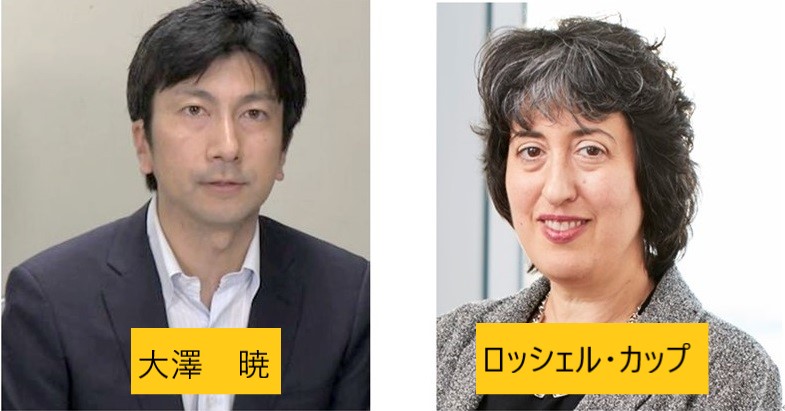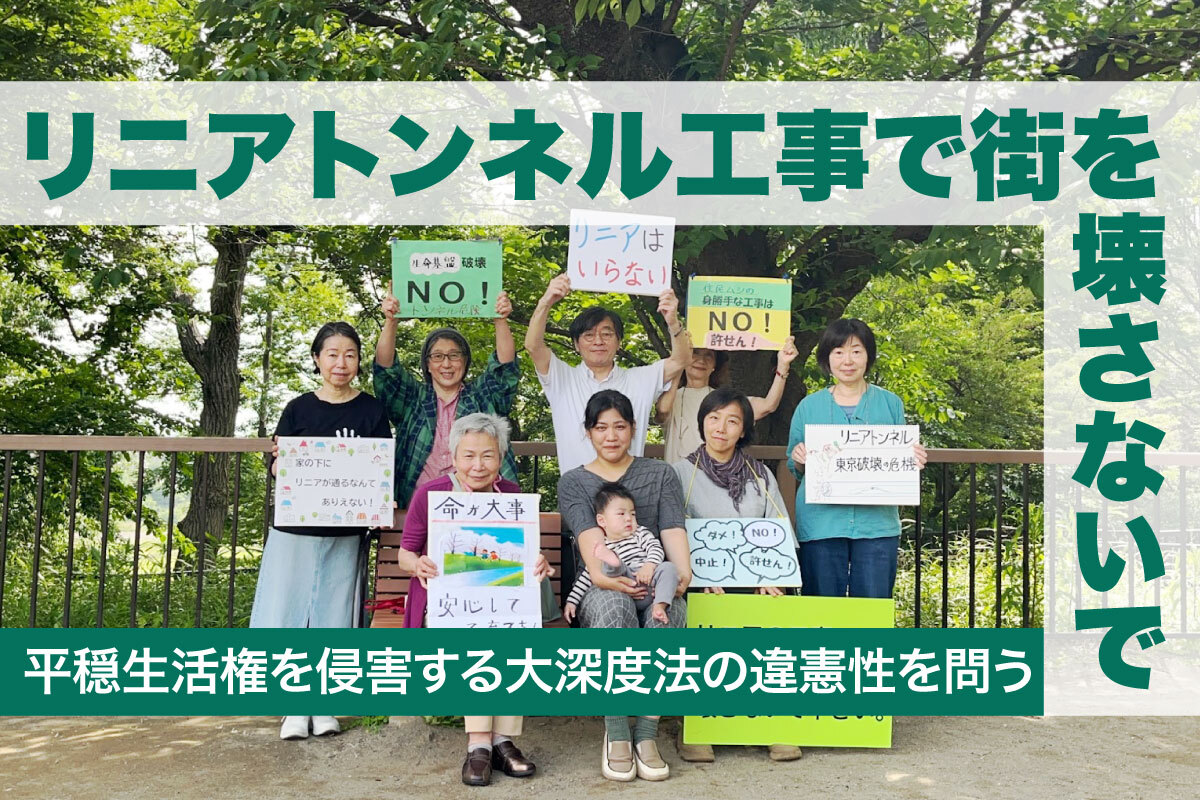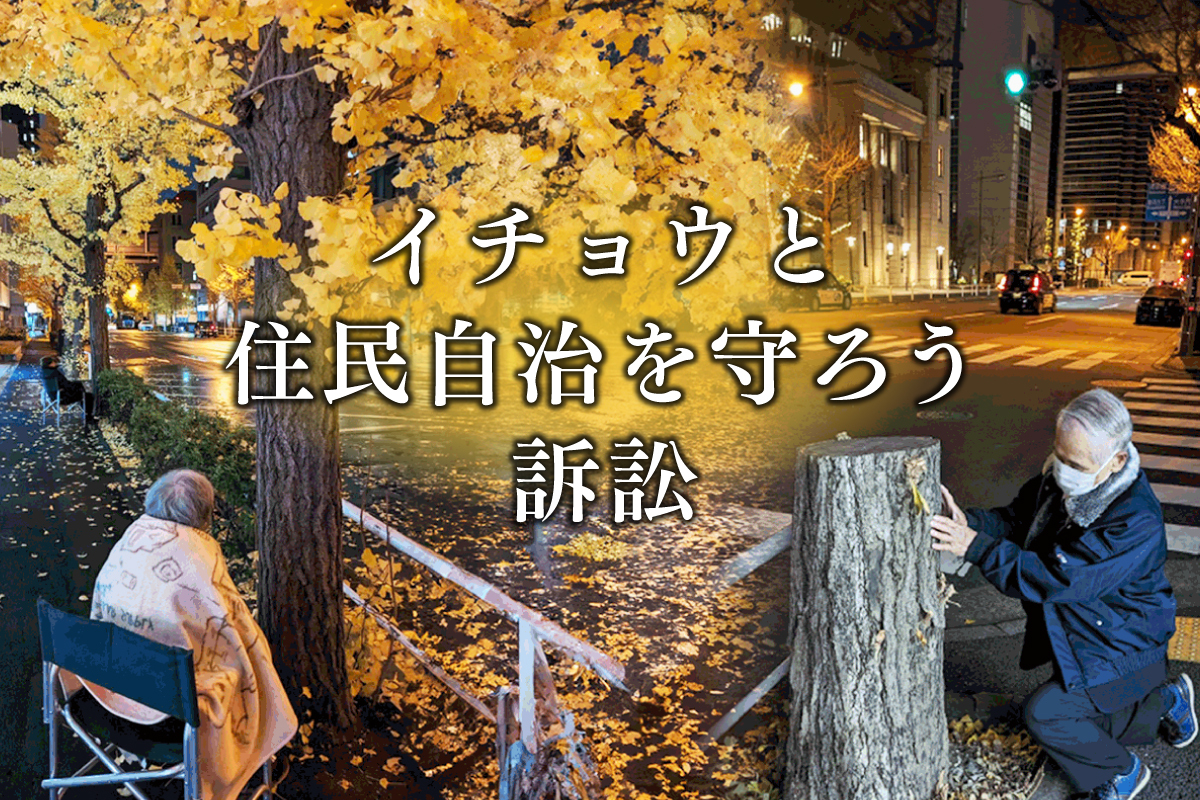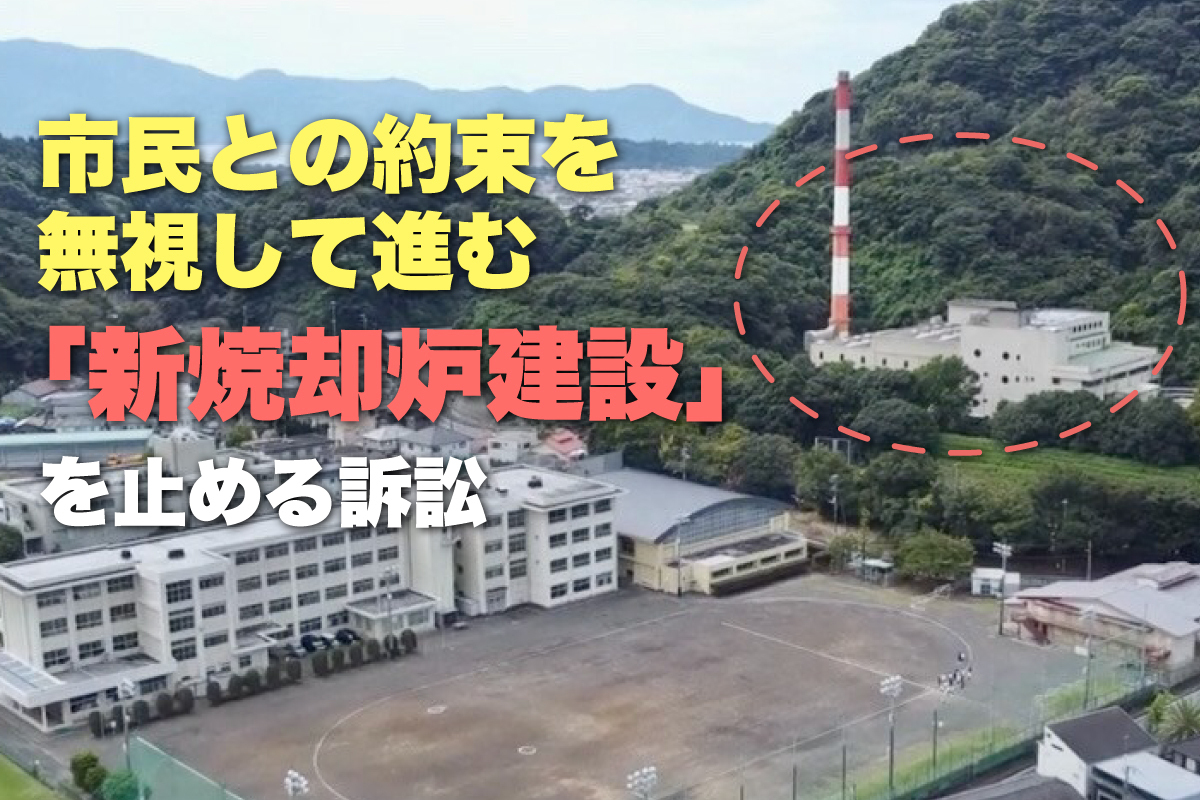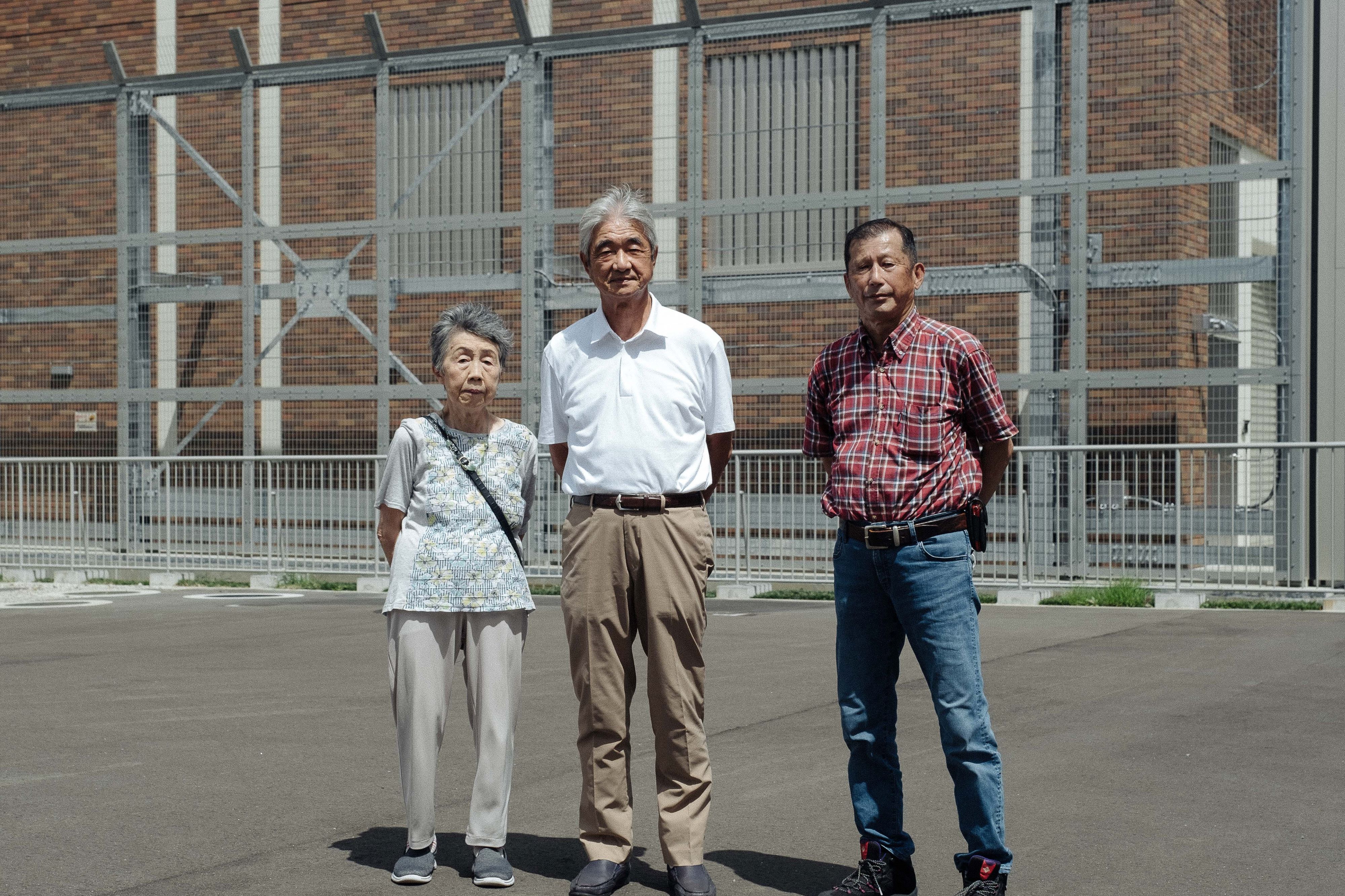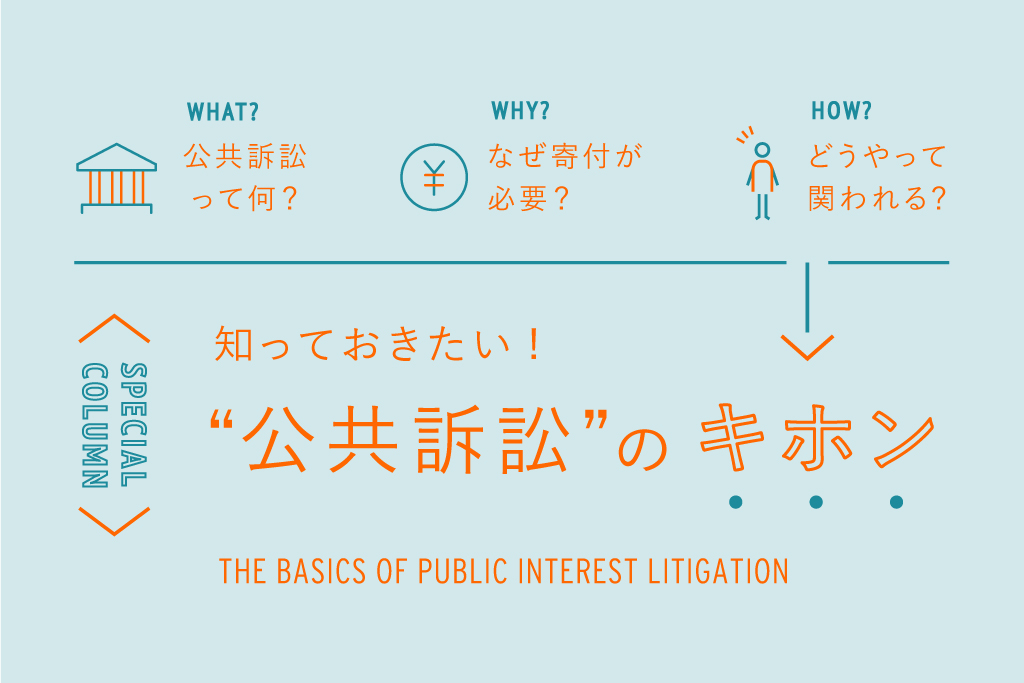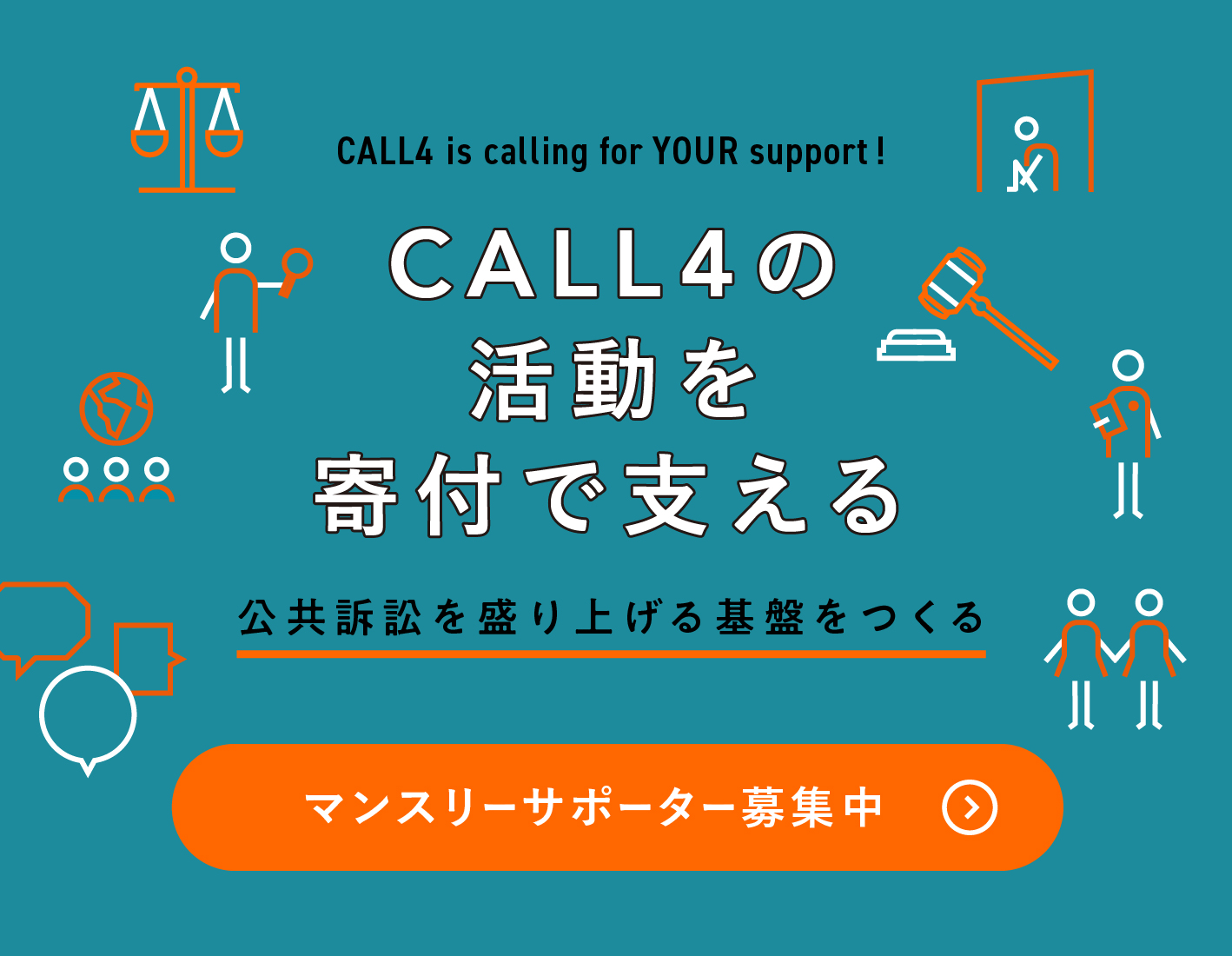神宮外苑を守ろう訴訟|100年の歴史と3000本超の樹木を未来へ Help Us Protect Jingu Gaien through Lawsuits | Preserve 100 Years of History and Over 3,000 Trees for the Future
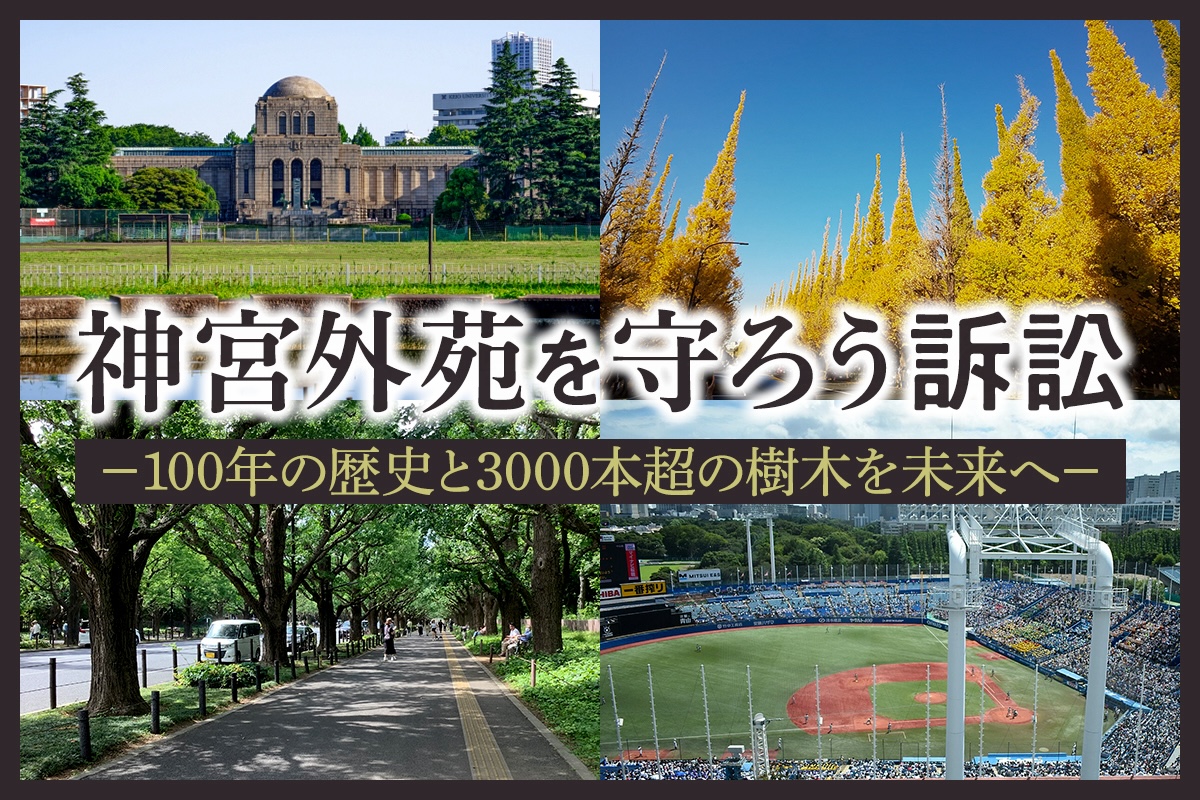
100年もの間、人々により守られ親しまれてきた神宮外苑が今、破壊の危機に瀕しています。都民のみならず国民全ての貴重な歴史的遺産であり、緑豊かな憩いの場である神宮外苑を現在の状態のまま次世代へ繋いでいきたい。行政の恣意的な手続をただしたい。その思いで周辺住民らが、2023年2月に東京都に再開発認可取り消しを、7月に新宿区に樹木伐採認可取り消しを求める訴訟を提起しました。計画の正当性を司法に問います。 Jingu Gaien, a green oasis in the center of Tokyo that has been cherished for nearly a century, is now on the brink of being destroyed by a large-scale redevelopment scheme. The beautiful views we see today may soon disappear. But with your help, we can preserve this special place for future generations. Area residents went to court in February, seeking to revoke the Tokyo Metropolitan Government’s approval for the redevelopment of the area and in July seeking to revoke Shinjuku Ward’s approval to cut down the trees. We ask the court to review and rule on the legitimacy of the entire plan.
【お詫びと訂正】当初の目標金額と資金の用途欄に一部変更がありました。確認不足によりこのような誤りが生じてしまったことを深くお詫びいたします。具体的な訂正内容については、進捗欄に投稿をしております。ご確認いただければ幸いです。
はじめに〜神宮外苑と再開発の問題〜
みなさんは、「神宮外苑」に行ったことはありますか。
もし訪れたことがなくても、名前を聞いたことはあるという方は多いのではないでしょうか。
100年もの長い間、人々に守られ親しまれてきた神宮外苑が今、破壊の危機に瀕しています。再開発により、なんと3,000本を超える樹木が伐採され、ほぼすべての景色と施設が作り替えられるというのです。
2036年に完成予定の再開発計画では、神宮球場と秩父宮ラグビー場は場所を変えて建て替えられ、高さ200メートル近い超高層の商業ビルやホテル、スポーツ関連施設などが造られ、それに伴って多くの樹木が伐採・植林されます。
このような大規模な再開発は少なくとも市民を交えた議論と検討の上で実施されるべきですが、十分な検討・検証もされないまま、今まさに樹木の伐採が始められようとしています。
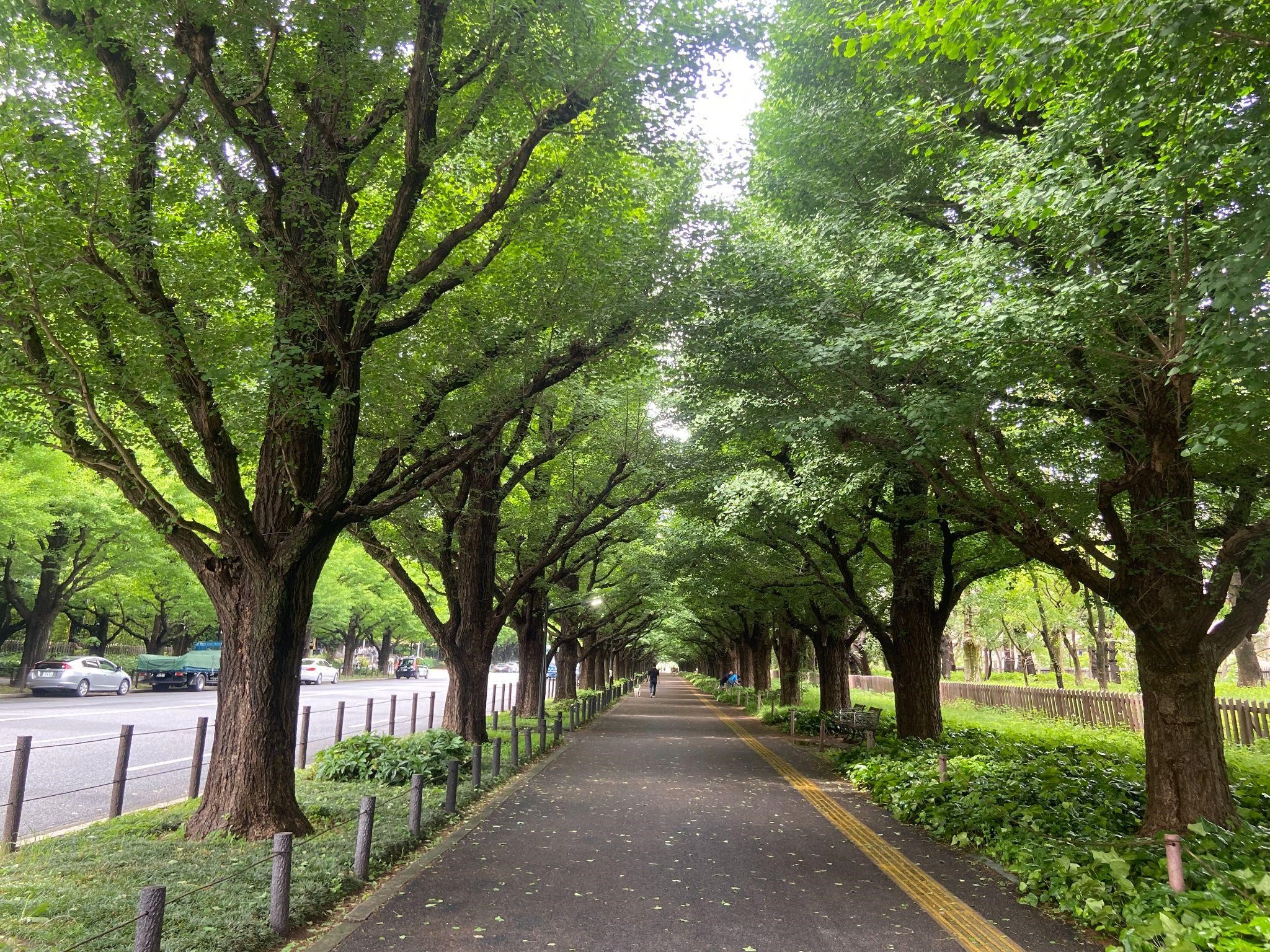
行政の手続きのあり方について、司法の場に問う
そこで私たちは、再開発事業の抜本的見直しを実現させて、神宮外苑を現在の状態のままで次世代へ繋いでいくため、訴訟を起こしました。具体的には、今年2月には東京都に再開発事業の認可取り消しを、7月には新宿区に樹木伐採の許可取り消しを求め、いずれも東京地裁に提訴しています。
訴訟に踏み切ることで、公の場で計画の正当性について問います。既に専門家らに指摘されている許認可プロセスにおけるさまざまな問題点について、中立の裁判官の判断を求めることができます。訴訟というのは権力と闘う武器にもなるのです。
100年もの間、守られ親しまれてきた神宮外苑
神宮外苑は、約100年前に国民の寄付や奉仕活動によって作られた公園で、日本ではじめて自然的景観を維持する「風致地区」に指定された場所です。神宮外苑は「風致地区」であるがゆえに高さ15mを超える建物を建てられない規制がもうけられていて、高層ビルが立ち並ぶ東京都心部で希少な緑あふれる公共空間となっています。特に有名な銀杏が連なる道路沿いの歩道は、東京を代表する並木道として知られています。
1919年の都市計画法によってつくられた、緑の保護に関する法制度では日本で最も歴史が古いもの。自然景観を保護するために、指定地区内の建築、宅地造成、樹木伐採など「風致の維持に影響を及ぼすおそれがある行為」は禁止・制限されています。
100年の時を経て、樹木は大きく育ち、300メートルにわたる146本の銀杏並木をはじめ、東京屈指の緑豊かな公園となっています。鮮やかな黄色に色づく銀杏並木は毎年多くの人を楽しませており、東京を代表する景色のひとつです。
また、神宮外苑は東京でも屈指のスポーツ空間です。野球場ではヤクルトスワローズや東京六大学の試合を青空の下で観戦することができます。秩父宮ラグビー場は観客席とフィールドが近く、迫力あるぶつかり合いを間近で見ることができます。市民が実際に体を動かすことができる野球場、フットサルコート、テニスコート、ゴルフ練習場、バッティングセンター、スケートリンクなど、多様なスポーツ施設は、比較的安価で気軽に利用できるとあっていつも多くの人で賑わっています。
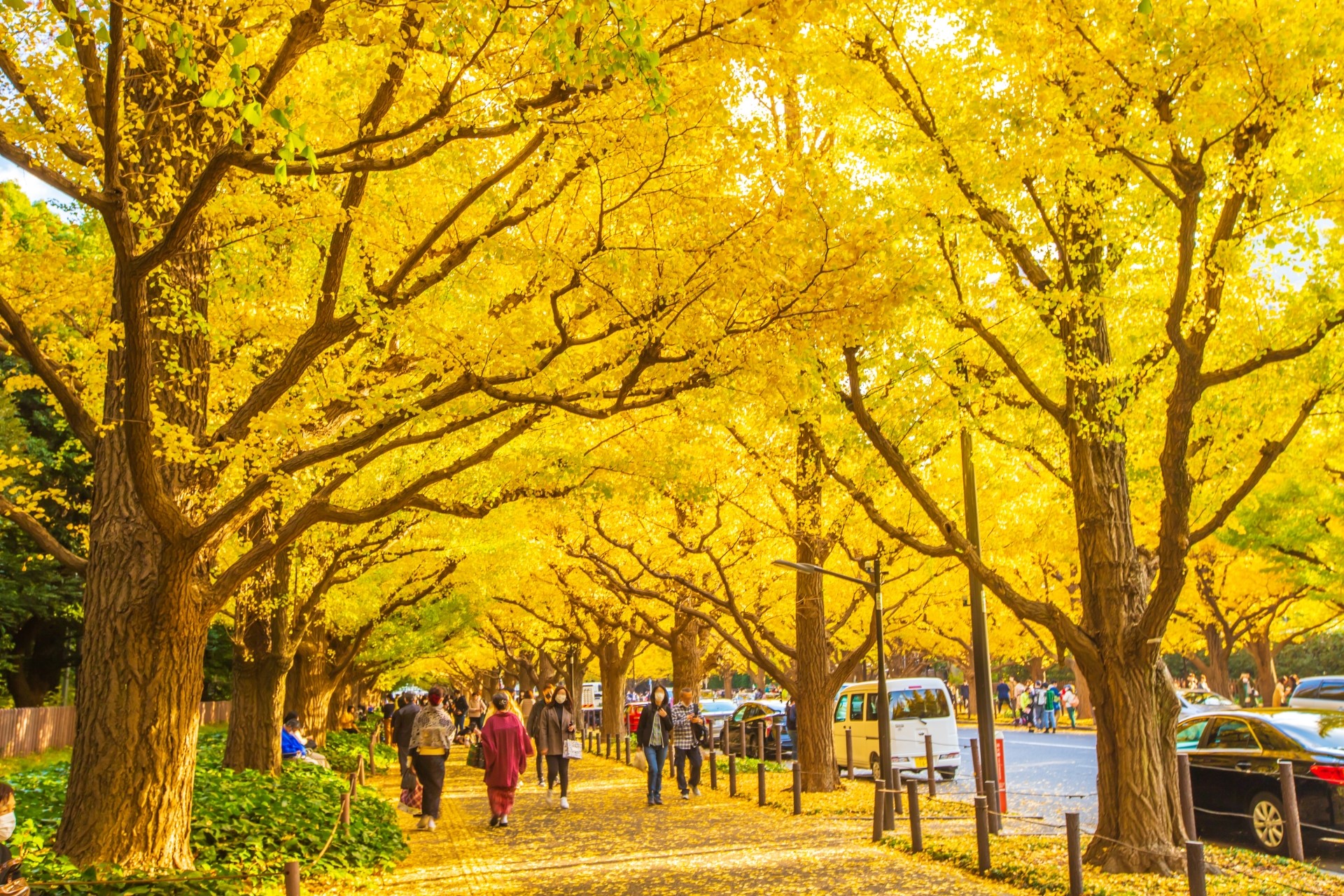
美しく輝くイチョウ並木の風景は、東京の秋の風物詩だ
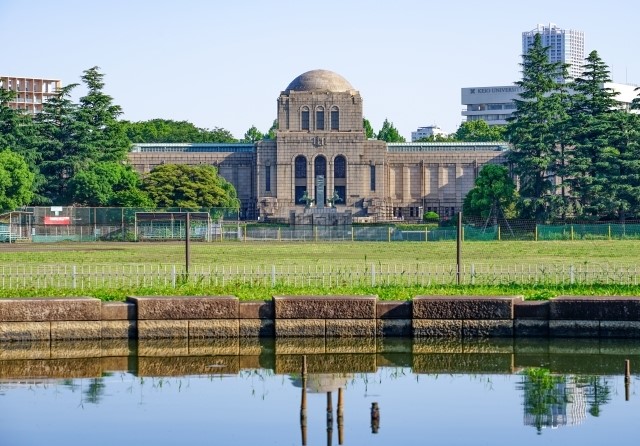
聖徳記念絵画館は、神宮外苑のシンボルともいえる存在
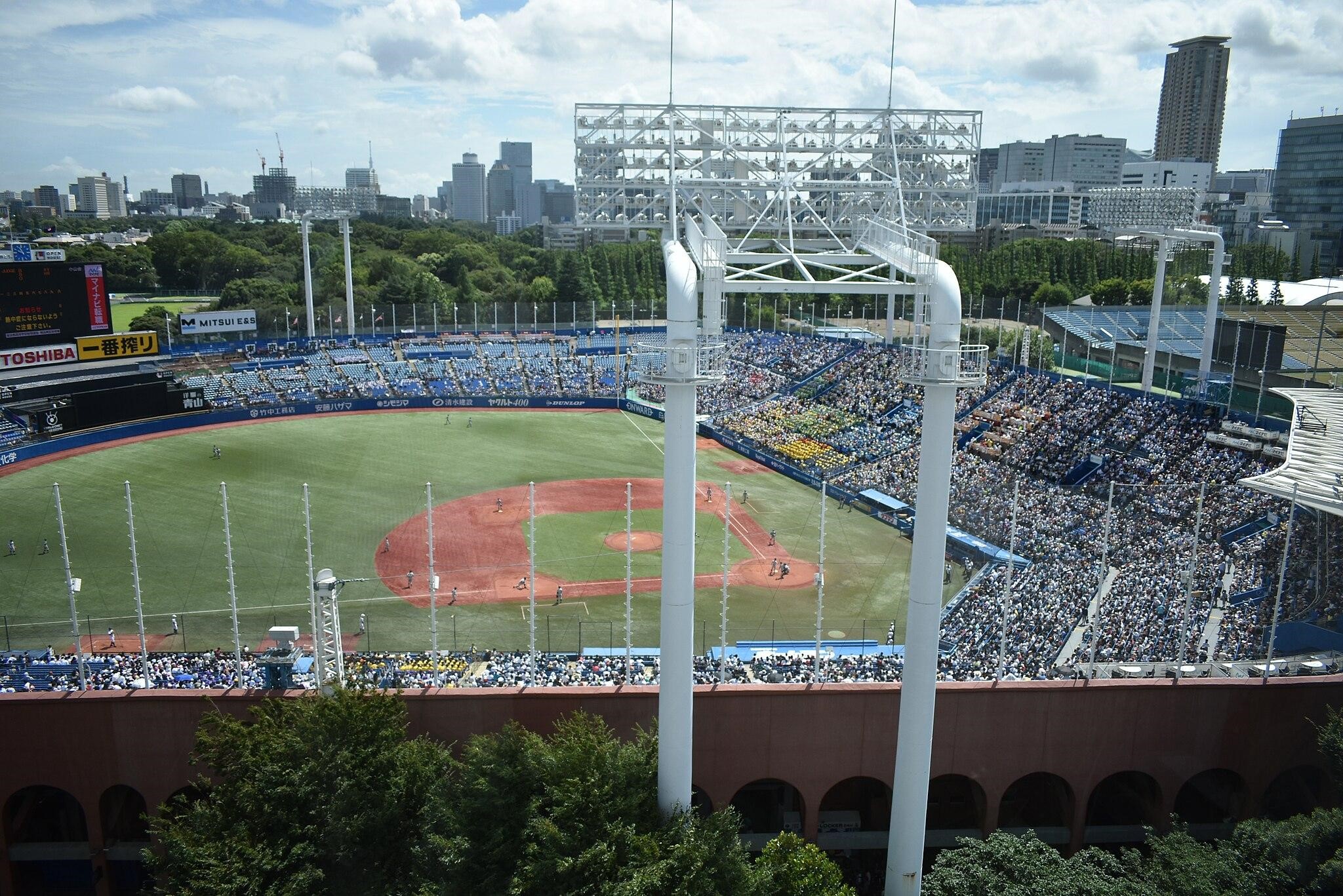
選手とファンの距離が近く一体感のある明治神宮野球場(出典:ウィキメディア・コモンズ [Wikimedia Commons])
行政と事業者が結託して進めてきた再開発計画
東京へのオリンピック招致が決まった後、三井不動産をはじめとした今回の事業者らは、東京都や森喜朗氏などと協議を始めました。行政と事業者とが結託して、国立競技場建替え後の神宮外苑全体を再開発の対象とする開発計画を練り上げたのです。本来であれば都市計画法の趣旨を遵守し、業者による濫用的な開発を防ぐべき行政がその役割を果たすことはありませんでした。
東京都都市整備局はウェブサイトで再開発計画の意義を以下のように説明しています。
「スポーツ施設等の老朽化や、競技環境・観戦環境の陳腐化、気軽にスポーツ等を楽しんだり、人々が自由に立ち入って緑を楽しめるオープンな空間が少ないこと、歩行者空間の不足による混雑や連続的なバリアフリー経路の不足などのまちづくり上の課題を抱えています。」
「今回のまちづくりでは、これらの課題解決を図りつつ、緑豊かな風格と活力を備えた世界に誇れるスポーツの拠点を形成するため、都が定めた『東京2020大会後の神宮外苑地区のまちづくり指針』等を踏まえ、4事業者が連携して取り組むものです。」
他にも事業者は、明治神宮の維持のために収益の見込める高層ビル建設が必要であることなどを説明をしていますが、環境保護や持続可能な社会への配慮についての説明は不足したままです。
何が失われるのか。再開発計画の問題は何か?
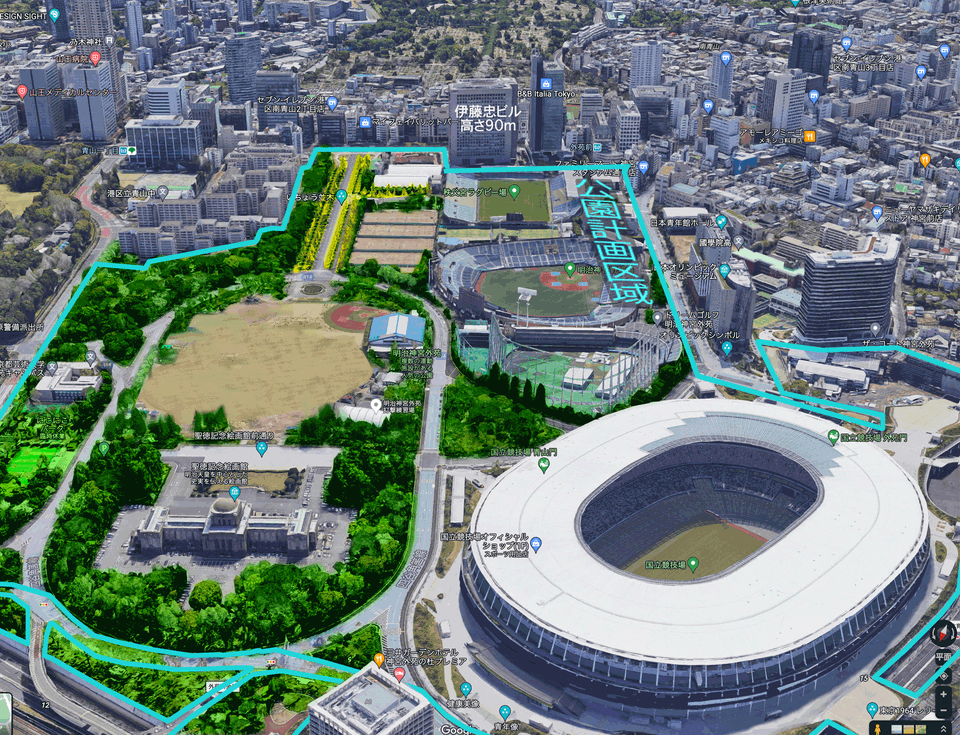
現在の姿に開発計画を重ねたGIF動画。球場とラグビー場は移転して新設され、3棟もの高層ビルが建設される。
ビル風が増し、樹木の生育に欠かせない日差しも遮られてしまう
100年もの長い間守られてきた景観や環境が失われる
風致地区に指定されている場所の3000本以上の樹木が伐採されることで、これまで守られてきた景観や環境が大きく損なわれます。樹木が育つには何十年もの年月が必要です。100年もの長い間大切に育て親しまれてきた樹木を一度伐採してしまったらそれを取り返すのは容易ではありません。
また、歴史的建造物と言える神宮球場及び秩父宮ラグビー場は建て替えのため取り壊され、その建設工事の影響で、建国記念文庫の森はほぼ失われ、絵画館前の芝生広場は1/3となり、ラグビー場前の銀杏並木や4列の銀杏並木は将来的に枯れる懸念が指摘されています。
公益性の高い施設が廃止される
都の計画では「世界に誇れるスポーツクラスター」が目的に掲げられていますが、これまで多くの一般市民が利用し親しまれてきた軟式野球場、ゴルフ練習場、フットサルコート、バッティングセンターなど公益性の高い施設が全て廃止される計画です。スポーツ施設として唯一残るのが高額な会員制テニスクラブというのは、公平性を欠いています。
近隣住民への影響:騒音、強風など
近隣住民は、10年以上に及ぶスタジアム建設期間中、騒音の被害に悩まされます。超高層ビルが複数立つことによる強風の被害も懸念されています。
気候変動が加速してしまう
今回の再開発によって56.5万トンものCO2が排出される、とされています。仮に10年計画で年間5.65万トンを排出するとすると、その量のCO2を吸収するには0.64万ヘクタールの森林が必要となるといわれています(東京の森林の約8%)。
さらに外苑の樹木を伐採することでCO2の吸収量も低減します。これらによって加速される気候変動による被害を受けることにもなります。
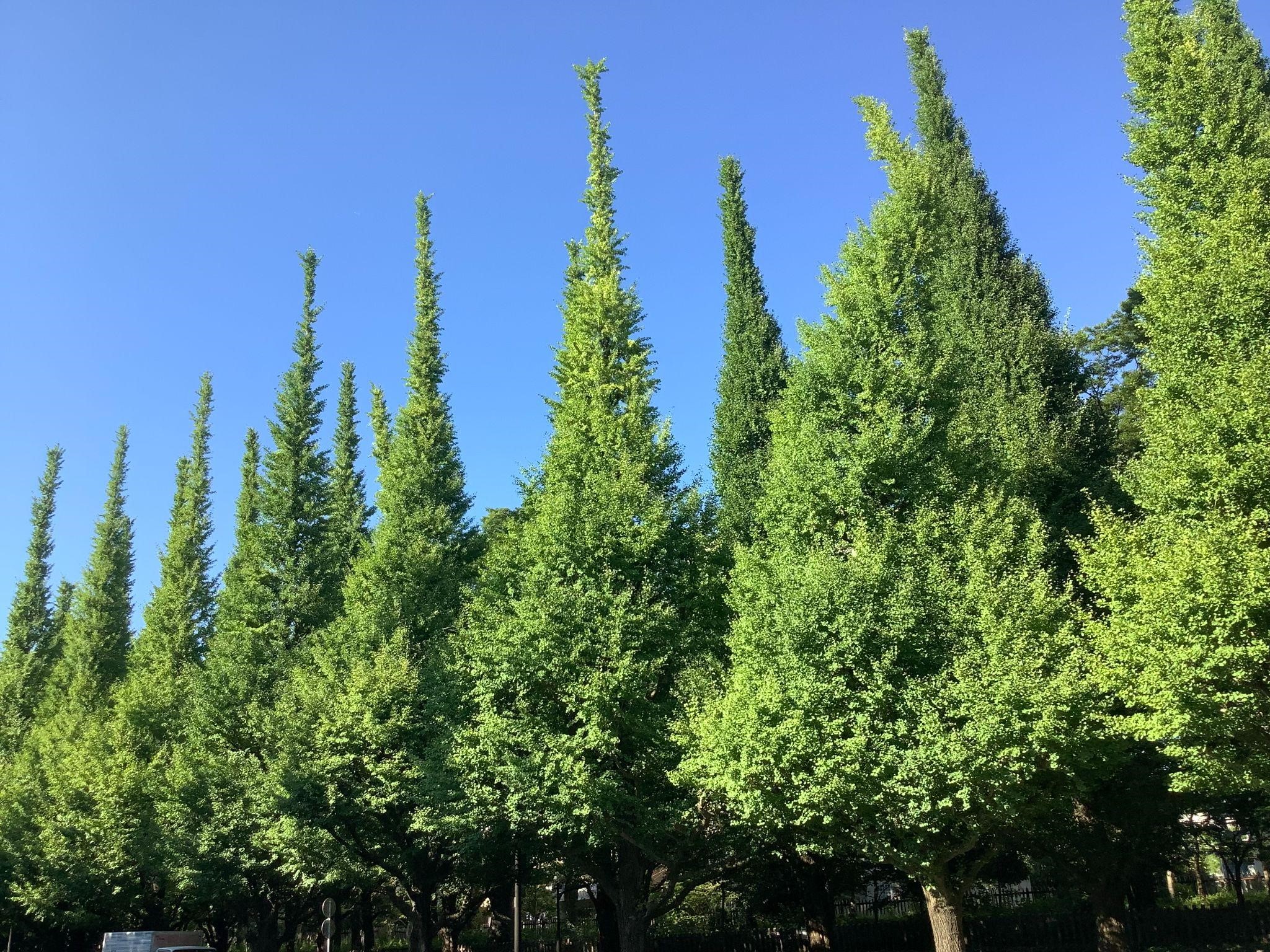
裁判で争う行政手続上の違法
私たちは大きくは3つの点で、今回の行政手続が違法であると考えています。
1.制度の濫用である
本来適用することが不合理な「公園まちづくり制度」を適用
「公園まちづくり制度」とは、都市計画公園区域内の、まだ公園として整備できていない空間(未供用区域)の一部を再開発できるようにすることを目的とするもので、本来は「公園として整備できていない」エリアが対象の制度です。ところが、神宮外苑地区の再開発にあたっては、現状のままで公園となるラグビー場等の敷地を「公園として整備できていない」区域として扱っています。
しかも、既に公園として利用される区域(供用区域)である神宮球場の敷地などを含む土地を、都市計画公園区域から外し、都市計画公園では建てられないオフィスビル等を建てられるようにしました。
このようにして実施される再開発は本来の「公園まちづくり制度」の趣旨から大きく逸脱する運用であり、制度の悪用又は濫用というべきです。
長い間未供用区域(誰もが自由に出入りし、利用できる公園等を供用区域とし、そうでない区域を未供用区域といいます。)となっている場所を含む都市計画公園や緑地において、民間による開発によって、まちづくりと公園緑地の整備を両立させながら、地域の課題を解決し、緑とオープンスペースを備えた快適な都市空間を創出するための東京都の制度です。
(「神宮外苑地区まちづくり」ウェブサイトより)
一部の事業者の利益のために高層ビル建設を可能に
神宮外苑を都市計画の公園区域から外したのは、本来は建てることができなかったはずの高層のオフィスビルを建設できるようにするためです。これに加えて、本計画はいわゆる容積率の移転制度を用いて、超高層ビルを建設できるようにしました。本来建物を建てるには市街地の環境を保護するために容積率の制限がありますが、その例外として容積率の移転(余った容積を近くの敷地に譲ること)を行うことにより、超高層ビルの建設が可能となります。しかし、そもそも容積率の移転はあくまで原則に反する例外的な規制の解除であり、神宮外苑地区では適用すべきではありません。この点について東京都都市計画審議会では十分な説明と審議がされておらず、その審議には瑕疵があります。
景観や環境を損なう高層ビルの建設及びそのための制度の濫用が、一部の事業者の利益のために進められているのではないでしょうか。
2.科学的判断でない
環境影響評価が十分になされていない(審議会に出すべき情報が出されていない)
東京都環境影響評価条例による手続である、環境影響評価(アセスメント)を受けるに際して、事業者は条例の趣旨に反し、また環境影響評価審議会の会長、部会長、委員の指示を無視し、必要な資料を提出していません。それにもかかわらず、事務局である東京都環境局は、一貫して早期終了を画策しました。
国際影響評価学会日本支部からも、環境影響評価審議会の進め方にも問題があった、「科学的な議論が極めて不十分だった」と指摘を受けています。
環境影響評価条例に基づき、環境に及ぼす影響について事前に調査・予測・評価を行い、環境影響評価書を作成した上で、評価書に記載した樹木の保全や良好な景観形成、周辺環境への配慮などを遵守することが開発事業者に義務付けられています。その一連の手続きを環境影響評価手続きといいます。環境アセスメントとも呼ばれます。
(「神宮外苑地区まちづくり」ウェブサイトより)
3.非民主的である
この計画には東京都と新宿区が関わっていますが、いずれも行政が市民の声を聞くことなく計画を推し進めています。
議論が行政内部の会議で行われ、市民参加の機会が確保されていない
東京都は、この公園まちづくり制度の適用について、「非公開」としました。東京都民が知らない密室で議論して、都市計画法の趣旨に反した運用で今般の適用決定を行ったのです。
法(都市計画法)に定められている公聴会や縦覧・意見書等の市民参加が全く行われていないという意味において、その手続が適正とは言えません。
秘密裏に風致地区の変更を行い、再開発・樹木伐採の許可が出されている
新宿区は、2020年に東京都の要請に基づいて、神宮外苑の再開発地区を規制の厳しい「風致地区」から、規制が緩い地域に指定を変更し、再開発で高層ビルを建てることを可能にしました。
しかも、それは新宿区民や区議会、都市計画審議会に諮ることもなく行われました。こうした民主的なプロセスなしでの変更は、公園の利用者である市民の声を意図的に聞かないようにしたもので、社会通念に反した裁量権の逸脱です。
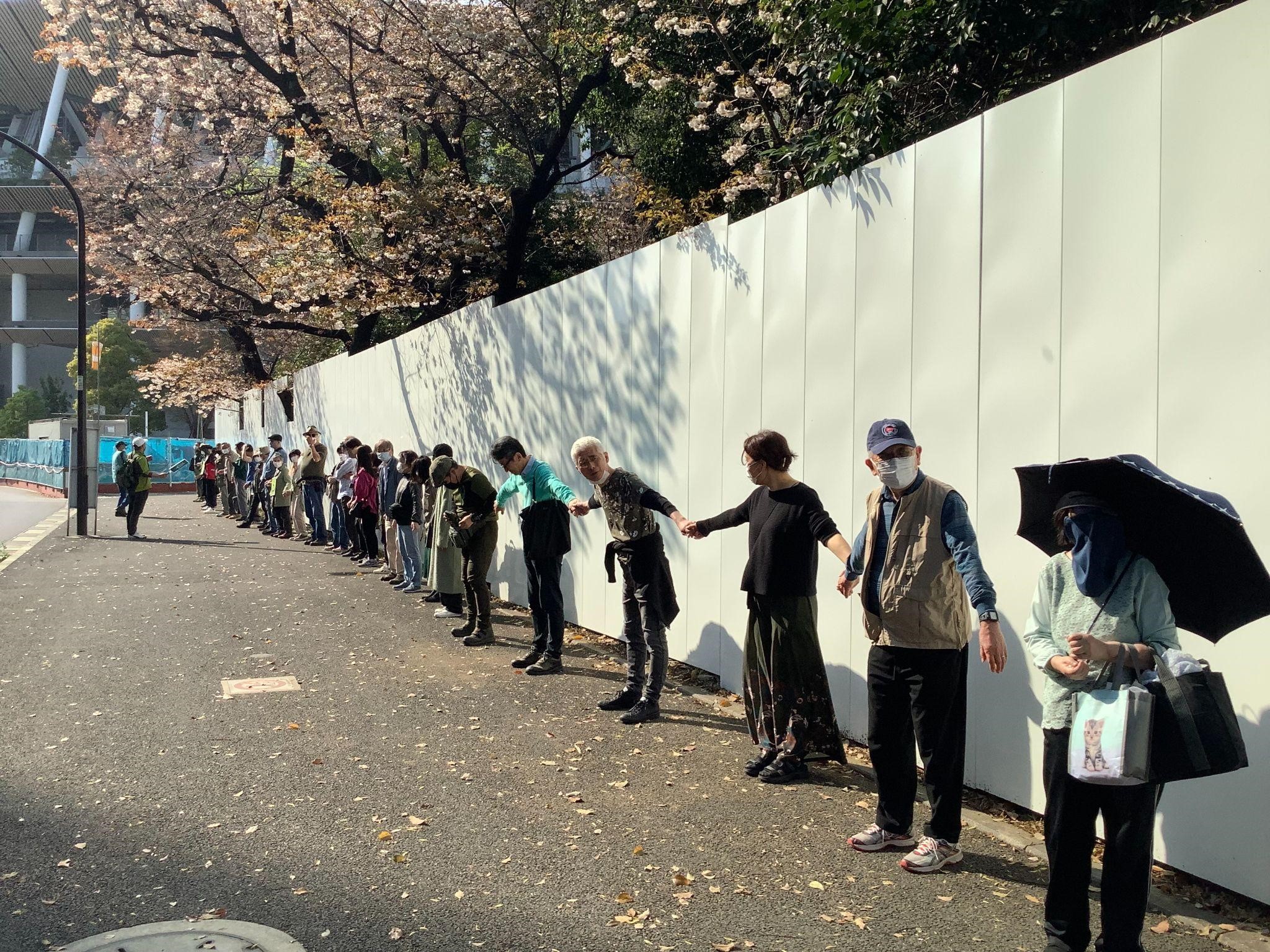
神宮外苑を愛する市民たちが手をつないで外苑を囲み、再開発見直しを求める様子
2つの裁判について
東京都に対する裁判(訴訟①)
2023年2月28日に東京都を相手に提訴した、神宮外苑の再開発事業施行の認可の取り消しを求める裁判。今回の再開発に、本来適用することが不合理かつ、意思決定過程に市民参加や情報公開が保障されない「公園まちづくり制度」を適用したことは、東京都や事業者が行った都市計画制度の濫用であると訴えています。
また、事業者らが環境影響審議会にこの事業によって伐採される樹木など出すべき情報を出さず、東京都がそれを咎めることなく環境影響評価を完了としたことは、環境影響を正しく評価したとは言いがたく、そのような環境影響評価書を元にした判断は、前提となる事実を誤認しているため裁量逸脱又は濫用であり、取り消されるべきだと主張しています。
新宿区に対する裁判(訴訟②)
2023年7月25日に新宿区を相手に提訴した、神宮外苑再開発に伴う樹木伐採の許可の取り消しを求める裁判。新宿区は、2020年に東京都の要請に基づいて、神宮外苑の再開発地区を規制の厳しい風致地区から、規制が緩い地域に変更し、再開発で高層ビルを建てることを可能にしました。しかも、その変更は新宿区民や区議会、都市計画審議会に諮ることもなく行われました。こうした民主的なプロセスを経ない変更は、社会通念に反した裁量権の逸脱であると訴えています。
無視され続けている対話を求める声
神宮外苑の再開発計画は10年にわたって準備されてきたものですが、その内容はほとんど一般に公開されてきませんでした。事業認可がされた後にも、東京都や新宿区がこの計画を進めるにあたって行った手続に多くの問題点があることが指摘されており、再開発反対の声は日ごとに高まっています。
| これまでの主要な出来事 | |
|---|---|
| 2010年 | 東京都が神宮外苑を再整備する構想を発表 |
| 2015年 | 現行の開発計画が発表され、事業者間で覚書が締結される |
| 2020年 | 新宿区が東京都の要請に基づき、神宮外苑の一部地域を風致地区から外す |
| 2023年2月17日 | 東京都が、神宮外苑地区第一種市街地再開発事業の施行を認可 |
| 2023年2月24日 | 坂本龍一氏_小池都知事へ手紙 |
| 2023年2月28日 | 周辺住民ら約60人が東京都に認可の取り消しを求め提訴(訴訟①) |
| 2023年3月2日 | ロッシェル・カップ氏が約50,000筆の署名と要望書を小池都知事に提出 |
| 2023年4月22日 | デモ参加6,000名|「Demonstration with Ryuichi Sakamoto」by D2021 |
| 2023年6月25日 | 村上春樹氏_ラジオで再開発について「個人的に強く反対しています」と述べる |
| 2023年7月25日 | 新宿区や周辺地区の住民5人が新宿区に樹木伐採許可の取り消しを求め提訴(訴訟②) |
| 2023年9月2日 | 桑田佳祐氏_神宮外苑の再開発をきっかけに制作した『Relay〜杜の詩』を発表 |
| 2023年9月7日 | ユネスコの世界遺産に関する諮問機関ICOMOS本部がヘリテージ・アラートを発出 |
| 2023年9月25日 | ロッシェル・カップ氏が文部科学大臣に要望書を提出 |
| 2023年9月26日 | 神宮外苑1000本の樹木を切らないで~再開発計画は見直しを!|署名225,000筆を突破 |
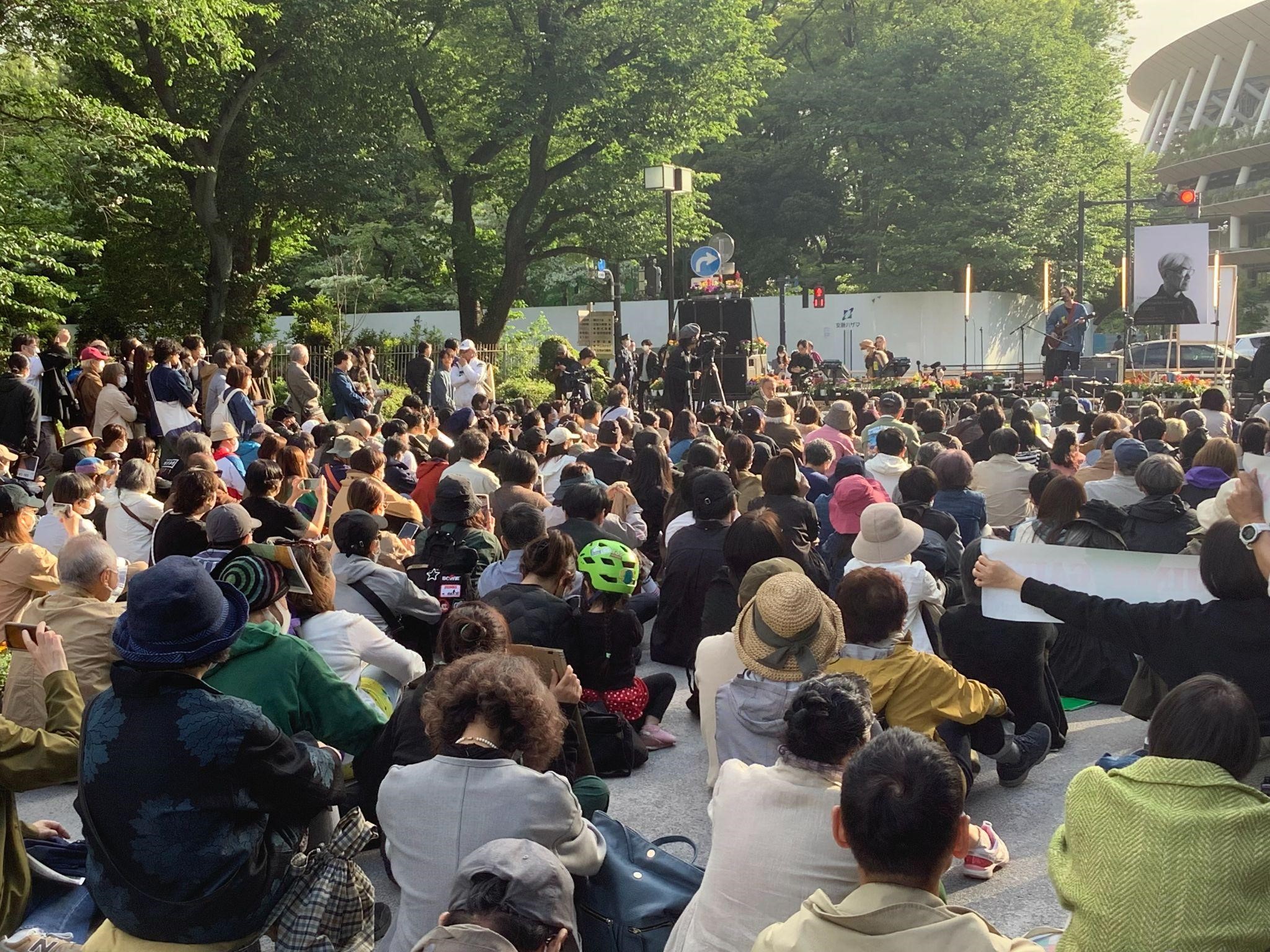
坂本龍一氏は神宮外苑の樹木伐採中止を最期まで訴え続けた。その意志を引き継ぎ行われた「Demonstration with Ryuichi Sakamoto」
原告団の思い
幼少期や大人になってから、あるいは都内で勤務していた時代などを含めて、神宮外苑の緑とその景観によって心の安らぎや緑からの治癒的効果を受け取ってきた人々が、原告となっています。
私たちは、この訴訟を提起する前から署名活動など反対運動を行ってきました。そして、多くの人がこうした運動を経て、事業者や行政側が都民市民の意見を聞き入れて事業の見直しをしてくれるものと期待していました。しかしながら、そうした見直しもなく、東京都による事業認可はなされてしまいました。これにより、道が閉ざされたと理解して、裁判所によってこのような理不尽で不合理な計画を止める判断をしてほしいとの思いで訴訟提起を決意しました。
再開発や樹木伐採は神宮外苑だけの問題ではありません。法令を恣意的に利用し、住民意見を聞こうとしない再開発や樹木伐採は日本全国で行われています。神宮外苑で前例を作ってしまえば、都市部の貴重な公園が次々と再開発のために切り崩されていく懸念があります。公共のものが一部の事業者の利益のために奪われていく流れを作ってはいけないと強く感じています。こうした住民を無視した開発は正しくない、ということを司法により明言してもらいたいです。
担当弁護士の思い
静謐で素晴らしい木々による景観が見られる歴史的な庭園である神宮外苑を破壊して、高層ビルを3棟も建築するような再開発事業を、環境破壊という観点から何としても止めなければならないという問題意識があります。
行政訴訟は住民側にとってはハードルが高く難しい裁判ですが、原告の皆さんの気持ちを、裁判の中でできる限り表現し、分かりやすい裁判をこころがけたいと思います。また、創意工夫しながら、行政訴訟の厚い壁を少しでもこじ開けられるように全力を尽くしたいと思います。
山下幸夫(東京弁護士会・新宿さきがけ法律事務所)
資金(寄付金)の使途
しっかりとした立証活動を行い、社会的インパクトを持つ訴訟活動を展開していくためには下記費用が必要となります。
みなさま、どうかご理解の上、ご支援賜りますようお願い申し上げます。
①訴訟提起のための必要経費(印紙代・郵便切手等)
現在、原告は東京都の訴訟で160人、新宿区の訴訟が5人です。原告を増やし、二次提訴、三次提訴を行ってこの訴訟の社会への影響力を高めていくことが再開発・伐採を止めることの力となり、法廷においても力になります。東京都の訴訟は期限が来ているため、これ以上原告を増やすことはできませんが、新宿区の訴訟では50人を目指して原告を追加募集したいと考えており、訴訟費用もその人数に合わせて準備ができればと考えています。なお、訴えの提起には訴額に応じた手数料(印紙代)が必要となるため、およそ300万円かかる予定の手数料等を寄付金から支出できればと考えております。
②証人等の交通費
20万円を予定しています。原告や弁護士が東京地裁での裁判に出頭する際の交通費や、さらには専門家の方などにお越しいただく際の交通費を想定しております。
③意見書費用
複数の専門家に意見書を執筆していただくことを予定しており、その為の費用として約120万円程度を想定しております。
④弁護士費用
今後も広がっていく訴訟活動について、専門的な知見を有する弁護士へ198万円のお支払いを予定しています。
⑤事務局費用ほか
多くの原告を束ねて訴訟活動を展開するためには、事務局機能が欠かせません。また、裁判に関連させた形での広報活動も広くおこなっていきたいと考えています。そのため、事務局費用等として36万円ほどを寄付金から支出できればと考えております。
※なお多くの寄付を頂戴し、すべての経費を支出してなお余剰が出た場合には、都市部の樹木保護活動に寄付したいと考えております。
再開発を止める裁判へご支援を!
多くの人が神宮外苑の景観や樹木、歴史を次の世代につないでいきたいと願い、また、強引な行政と事業者の計画に反対の声をあげています。22万筆を超える署名が集まってもなお、無視して強引に計画を進めようとしているということ自体、大きな問題です。
訴訟という手段を取ることで裁判所という公の場で問題を明らかにし、理不尽で不合理な計画を止める判断をしてほしい、との思いで訴訟提起を決意しました。
この裁判への支援が今回の再開発を止め、対話を促す大きな力になります。
賛同いただける方は、ご支援・応援・シェアをどうぞよろしくお願いいたします。
神宮外苑訴訟ウェブサイトにも近況を更新しています。
Apologies and corrections: some changes have been made to the original target amount and the use of funds section. We sincerely apologise for this error which occurred due to a lack of confirmation. The specific corrections have been posted in the progress section. We would be grateful if you could check it.
Introduction | Jingu Gaien and the Issue of Redevelopment
Have you ever been to Jingu Gaien? If so, you know its beauty and benefits. If not, you’ve probably heard its name. For nearly 100 years, Jingu Gaien has been preserved and cherished by people from all walks of life. But now the more than 3,000 trees and the rare green space they create are facing destruction because of a plan to redevelop the area into shops, hotels and sports facilities.
Under a redevelopment plan scheduled for completion in 2036, both the Jingu Stadium and the Chichibunomiya Rugby Stadium would be rebuilt on new sites. Their relocation will make room for towering commercial buildings and hotels, some of which will reach heights of nearly 200 meters. And 1000 large trees will need to be removed in order to make way for the new buildings. Replacement trees will be planted but they would likely be much fewer in number and would take years to mature.
Such a large-scale redevelopment should be carried out only after thorough discussions and citizen participation. However, this project never included that kind of public dialogue and the tree cutting is about to begin.

Going to court to challenge official administrative procedures
In an effort to give the trees a stay of execution, and force a fundamental reevaluation of the redevelopment plan, we have initiated legal proceedings. In February 2023 we filed a lawsuit against the Tokyo Metropolitan Government seeking the revocation of its approval for the redevelopment. Then in July, we sued Shinjuku Ward seeking the revocation of the tree-cutting permit issued to the developers. Both cases are pending in the Tokyo District Court.
By taking such strong legal action, we aim to challenge the legitimacy of the plan in a public forum. Experts have already questioned whether the approvals were legally obtained and we now seek the opinions of impartial judges on issues related to the approvals process. We hope that through such litigation, we can hold those in power accountable.
For Over 100 Years, Jingu Gaien Has Been Protected and Cherished
Jingu Gaien is a park that was created
nearly 100 years ago through public donations and volunteer efforts. It was designated as a "Scenic District," becoming the first place in Japan where a landscape was officially preserved.. Because it is a Scenic District, regulations were long in place to prohibit the construction of buildings taller than 15 meters, making it a rare green public space amid the skyscrapers of central Tokyo. No one today can doubt the mental health benefits of fresh air and leafy zones, and the tree-lined boulevard along the famous Ginkgo Avenue, in particular, is one of Tokyo's iconic tree-lined streets.
The City Planning Act of 1919 established the Scenic District designation, the oldest legislation in Japan related to preserving green space. In order to protect special landscapes, activities within designated areas that could "affect the preservation of the scenic beauty," such as construction, land development, and tree cutting, are prohibited or restricted by law.
Over the past century, the trees in Jingu Gaien have grown significantly, and now include a 146-tree Ginkgo Avenue stretching for 300 meters, making it one of Tokyo's most lush parks. The vibrant yellow leaves along Ginkgo Avenue in autumn delight many locals and visitors every year and are one of Tokyo's most famous sights.
Furthermore, Jingu Gaien is one of Tokyo's premier sports spaces. At the baseball stadium, you can watch the Yakult Swallows or the Tokyo Big6 Baseball League in action, under the open sky. The Chichibunomiya Rugby Stadium offers spectators a close-up view, with the seating and the field in close proximity. Other facilities, including softball fields, futsal courts, tennis courts, golf practice range, batting center, and skating rink where citizens can actively participate, are relatively affordable, easily accessible and always bustling with people.

The beautiful scenery of the shining Ginkgo Avenue is a symbol of Tokyo's autumn.

The Meiji Memorial Picture Gallery can be considered the symbol of Jingu Gaien.

The Jingu Stadium offers a close-knit atmosphere between players and fans, creating a sense of unity.
(Source: Wikimedia Commons[https://w.wiki/7ZTB])
How the Developers and the Government Collaborated to Create the Redevelopment Plan
After Tokyo won the bid for the Olympics, the developers involved in this project, including Mitsui Fudosan, began discussions with entities such as the Tokyo Metropolitan Government and individuals like Mori Yoshirō. Through this collaboration between the government and the developers, a plan was created that encompassed the entire Jingu Gaien area, following on the reconstruction of the nearby National Stadium.
Instead of this closed-door approach, the government should have adhered to the spirit of urban planning laws and prevented abusive development by private entities, but it did not.
The Tokyo Metropolitan Bureau of Urban Development explains the significance of the redevelopment plan on its website:
"The aging of sports facilities, the obsolescence of the competitive and spectator environments, the shortage of open spaces for people to easily enjoy sports and nature, congestion due to insufficient pedestrian space, and a lack of continuous barrier-free routes are some of the urban development challenges we face."
"In this urban development project, while addressing these challenges, we aim to create a world-class sports hub with a rich green character and vitality, following the 'Urban Development Guidelines for the Jingu Gaien Area after the Tokyo 2020 Games' set by the Tokyo Metropolitan Government. Four developers are collaborating on this effort."
The developers have also argued that the construction of tall buildings with revenue potential is necessary for the maintenance of Jingu Gaien, but they don’t talk about any plans for conserving the environment or for encouraging a sustainable society through this project.
What Will be Lost? What's wrong With the Redevelopment Plan?

A GIF animation that overlays a development plan onto the current site. The construction of three high-rise buildings will increase wind turbulence and obstruct the sunlight essential for trees to grow.
Loss of Landscape and Environment that Have Been Protected for nearly 100 Years
More than 3,000 trees in the designated Scenic District will be cut down, significantly compromising the landscape and environment. Trees require decades to grow, and once these trees, which have been nurtured and cherished for decades, are cut down, it will not be easy to replace what is lost. Additionally, the historically significant structures, the Jingu Stadium and the Chichibunomiya Rugby Stadium, will be demolished with new facilities changing the surrounding landscape. The National Foundation Memorial Archives Forest is expected to be almost lost, the grassy plaza in front of the picture gallery will be reduced to one-third of its current size, and there are concerns about the Ginkgo trees in front of the Rugby Stadium being removed and the four main rows of Ginkgo trees withering in the future, due to the lack of sunlight and construction-related damage to their roots.
Discontinuation of Public Facilities
Despite the Tokyo Metropolitan Government's stated goal of creating a "world-class sports cluster," the plan involves discontinuing all public sports facilities, such as the community softball fields, golf practice range, futsal courts, batting center, and more. These facilities have been widely used and cherished by the general public. The only remaining sports facility will be an exclusive, expensive tennis club, which cannot provide fair access to the public.
Impacts of Noise and Wind Turbulence on Nearby Residents
Nearby residents will suffer from noise pollution during the construction period, which is expected to last more than 10 years. There is also concern about wind turbulence caused by the addition of multiple high-rise buildings.
Acceleration of Climate Change
The redevelopment plan is expected to emit 565,000 tons of carbon dioxide (CO2), potentially accelerating climate change. If 565,000 tons are emitted annually for a 10-year period, it would take approximately 0.64 million hectares of forest (about 8% of Tokyo's forests) just to absorb that amount of CO2. Furthermore, the removal of trees in Jingu Gaien would reduce the city’s capacity to absorb CO2. These factors could help speed climate change and the problems linked to it.

Why we went to court to challenge the Administrative Procedures
We believe that the current administrative procedures are illegal, mainly for the following three reasons:
1.Abuse of the System
The application of the "Park Town Development Program", which is inherently unreasonable in this context.
The "Park Town Development Program" is intended for areas within urban planning park zones that have not yet been developed as parks (undeveloped zones). It is a system designed for areas that are "not yet developed as parks." However, in the case of the Jingu Gaien plan, the existing rugby field, which is to remain as a park, is unreasonably treated as an "undeveloped area for park development." Furthermore, the land that includes the grounds of the existing Jingu Stadium, already used as a park, will have its designation as a park under the urban planning code removed, to allow for the construction of office buildings and other structures that would not be permitted within a park zone. This way of implementing redevelopment significantly deviates from the original intent of the "Park Town Development System" and can be seen as an abuse of the system.
is a Tokyo Metropolitan Government program aimed at resolving community issues while simultaneously promoting urban development and the construction of parks and green spaces in city planning parks and green areas, include areas that have long been unused (where anyone can freely enter and use as parks, etc., are considered 'used' areas. The system encourages private sector development to create a comfortable urban space with greenery and open spaces.
(From the 'Jingu Gaien District Town Development' website)
2.Non-Scientific Decision-Making
Inadequate Environmental Impact Assessment (EIA) (essential information was not provided to the review committee)
During the Environmental Impact Assessment (EIA) process (held in accordance with the Tokyo Metropolitan Government's Environmental Impact Assessment Ordinance), the developer’s actions were contrary to the spirit of the ordinance. It has ignored instructions from the EIA review committee's chairman, subcommittee chairpersons, and members, failing to submit the necessary documentation. Despite this, the Tokyo Metropolitan Bureau of Environment, acting as the secretariat, has consistently sought an early conclusion to the process. The Japan Society for Impact Assessment has also pointed out issues with the way the EIA review was conducted, stating that "scientific discussions were extremely insufficient."
3.Lack of Democratic Participation
The involvement of the Tokyo Metropolitan Government and Shinjuku Ward in this plan has proceeded without listening to the voices of citizens.
Discussions were held in closed meetings within the administration, with no opportunities for citizen participation.
The Tokyo Metropolitan Government decided to apply the "Park Town Development Program" behind closed doors, away from the eyes and ears of Tokyo citizens, and implemented the decision in a manner that goes against the spirit of the Urban Planning Act. Procedures defined by law, such as public hearings and opportunities for citizens to review and submit opinions, did not take place, a fundamental flaw in the process.
Changes to the Scenic District designation and approvals for redevelopment and tree felling have been made in secret.
Shinjuku Ward, in response to a request from the Tokyo Metropolitan Government in 2020, changed the designation of the Jingu Gaien redevelopment area from a strictly regulated Scenic District to an area with lax regulations, allowing the construction of high-rise buildings through redevelopment. This change was made without consulting the Shinjuku Ward residents, ward council, or the ward’s urban planning review committee. Such undemocratic action was taken intentionally to avoid hearing the voices of citizens who are users of the park, falling far short of what citizens expect from their government.

The citizens who love Jingu Gaien join hands to encircle a section of the park, demanding a reconsideration of the redevelopment plans.
Regarding Our Two Lawsuits:
Lawsuit against the Tokyo Metropolitan Government (Lawsuit #1):
This lawsuit was filed against the Tokyo Metropolitan Government on February 28, 2023, seeking annulment of the approval for the Jingu Gaien redevelopment plan. We argue that the way the 'Park Town Planning System' was applied was inherently unreasonable and lacked guarantees for citizen participation and information disclosure in the decision-making process. We consider this an abuse of the urban planning system by the Tokyo Metropolitan Government and project developers.
Furthermore, we argue that the developers failed to provide essential information, such as details about the trees to be felled, to the Environmental Impact Assessment Committee. We also assert that the Tokyo Metropolitan Government completed the environmental impact assessment without properly evaluating the project’s actual environmental impact. The decisions based on such an environmental impact assessment report are either negligent or an outright abuse, since they misinterpret underlying facts, and thus should be revoked.
Lawsuit against Shinjuku Ward (Lawsuit #2):
This lawsuit was filed against Shinjuku Ward on July 25, 2023, seeking the annulment of the permit for tree felling associated with the Jingu Gaien redevelopment plan. In 2020, based on the request of the Tokyo Metropolitan Government, Shinjuku Ward changed the redevelopment area of Jingu Gaien from a heavily regulated Scenic District to an area with looser regulations, enabling the construction of high-rise buildings. Moreover, this change was made without consulting Shinjuku Ward residents, the ward council, or the urban planning review committee. We argue that such a change – without undergoing a democratic process – constitutes an abuse.
Calls for Dialogue Repeatedly Ignored
The Jingu Gaien redevelopment plan has been in preparation for a decade, yet its details have been largely kept from the public. But now, numerous issues have been raised regarding the procedures carried out by the Tokyo Metropolitan Government and Shinjuku Ward in advancing this plan, even after project approval. As a result, opposition to the redevelopment is growing daily.
| The Key Events Leading Up to the Current Situation: | |
|---|---|
| 2010: | The Tokyo Metropolitan Government announced the concept of redeveloping Jingu Gaien. |
| 2015: | The current redevelopment plan was announced, and a memorandum of understanding was signed by the developers. |
| 2020: | Shinjuku Ward changed the designation of a portion of Jingu Gaien from a Scenic District based on a request from the Tokyo Metropolitan Government. |
| Mar 2, 2022: | Rochelle Kopp submitted about 50,000 signatures and a request letter based on her online petition to Governor Yuriko Koike, asking her to not approve the redevelopment plan. |
| Feb 17, 2023: | The Tokyo Metropolitan Government approved the implementation of the category 1 urban redevelopment project in the Jingu Gaien area. |
| Feb 24, 2023: | The music pioneer Ryuichi Sakamoto wrote a letter to Governor Koike. |
| Feb 28, 2023: | Approximately 60 local residents and others filed a lawsuit against the Tokyo Metropolitan Government seeking the annulment of the approval (Lawsuit #1). |
| Mar 2, 2023: | Rochelle Kopp submitted about 50,000 signatures and a request letter to Governor Koike. |
| Apr 22, 2023: | 6,000 participants joined a "Demonstration with Ryuichi Sakamoto" organized by the volunteer group D2021. |
| June 25, 2023: | The author Haruki Murakami, speaking on the radio, expressed strong personal opposition to the redevelopment. |
| July 25, 2023: | Five residents from Shinjuku Ward and surrounding areas filed a lawsuit against Shinjuku Ward seeking the cancellation of the tree-felling permit (Lawsuit #2). |
| Sep 2, 2023: | Keisuke Kuwata of the popular rock group Southern All Stars released the song "Relay /Song of the Forests," which was created in response to the Jingu Gaien redevelopment. |
| Sep 7, 2023: | The headquarters of UNESCO's World Heritage advisory body, The International Committee on Monuments and Sites (ICOMOS), issued a Heritage Alert for Jingu Gaien. |
| Sep 25, 2023: | Rochelle Kopp submitted a request letter to Minister of Education, Culture, Sports, Science and Technology. |
| Sep 26, 2023: | Over 225,000 signatures are collected for the petition "Protect Jingu Gaien's trees! Rethink the Redevelopment Plan!" |

Ryuichi Sakamoto continued to call for the cancellation of tree felling in Jingu Gaien until his last moments. He died in March but this determination lived on in the “Demonstration with Ryuichi Sakamoto”
Message from the Plaintiffs
The plaintiffs are people who have experienced the tranquility and healing effects of the greenery and landscape of Jingu Gaien at different stages of their lives, from childhood to adulthood, and during their time working in Tokyo.
We have been engaged in activities such as signature campaigns and protests against this redevelopment plan even before filing this lawsuit. Many people, through such movements, hoped that the developers and the authorities would reconsider the plan and listen to the opinions of Tokyo residents. However, no such reconsideration or listening took place, and the Tokyo Metropolitan Government went forward with approval of the project.
Realizing that we needed to take a different approach, we decided to file suit in the hope that the court will stop this unreasonable and unjust plan.
Redevelopment and the unnecessary cutting down of trees are not issues limited to Jingu Gaien. They are happening all over Japan, in blatant disregard of residents' opinions and exploiting legal loopholes. If a precedent is set in Jingu Gaien that parks can be wantonly developed, there is a concern that valuable urban parks in cities across the country will be dismantled for redevelopment, one after another like dominoes. We strongly feel that we must not create a trend where public assets are taken away for the benefit of a few developers. We want the courts to make it clear that development that ignores residents is neither legal nor in the best interests of Japan and its people.
Message from the Legal Counsel
“I feel strongly about the need to prevent the redevelopment plan that would destroy the historical garden of Jingu Gaien with its serene and magnificent trees and construct three high-rise buildings, from a perspective of avoiding environmental destruction.
Suing government entities can be challenging and have high hurdles for the residents, but I want to represent the feelings of the plaintiffs as much as possible and strive for a clear and understandable trial. Additionally, using creative thinking, I will do my best to break down the thick barriers that make it so difficult for citizens to sue the government and win.”
Yukio Yamashita (Tokyo Bar Association, Shinjuku Sakigake Law Office)
Use of Donations
It costs money to carry out thorough evidentiary activities and pursue litigation with social impact. We ask for your understanding and support.
Necessary expenses for filing lawsuits (revenue stamps, postage, etc.):
Currently, there are 160 plaintiffs in the Tokyo lawsuit and 5 plaintiffs in the Shinjuku City lawsuit. Increasing the number of plaintiffs and increasing the influence of this lawsuit on society by filing a second and third lawsuit will give us the power to stop the redevelopment and associated cutting down of trees, and will also give us strength in court. Although we cannot increase the number of plaintiffs for the Tokyo lawsuit because the deadline has passed, we would like to recruit additional plaintiffs for the Shinjuku City lawsuit, aiming for 50 plaintiffs, and we hope to be able to prepare for the cost of the lawsuit to match that number. We hope to be able to pay for the cost of the lawsuits from the funds donated. The cost is expected to be approximately 3 million yen, since the filing of a lawsuit requires a fee (stamp fee) based on the amount that is being sued for.
Transportation expenses for witnesses and others:
We anticipate an expense of 200,000 yen. This includes transportation expenses for plaintiffs and lawyers when appearing in the Tokyo District Court for the trials, as well as transportation expenses for experts and other individuals when they come to provide testimony.
Written opinion expenses:
We plan to ask experts for written opinions, and we anticipate these will cost approximately 1.2 million yen.
Lawyer fees:
We anticipate a payment of 1.2 million yen to lawyers who possess specialized knowledge for the ongoing and expanding litigation activities.
Administrative office and other expenses:
To coordinate and expand litigation activities with many plaintiffs, hiring an administrator is indispensable. We also wish to conduct public relations activities related to the litigation. Therefore, we hope to use approximately 0.36 million yen from the donation funds for administrative expenses and other related expenses.
*In the event that we receive many donations and there is a surplus after covering all expenses, we would like to donate it to support urban tree conservation.
Support the Lawsuit to Stop the Redevelopment!
Many people wish to pass on the landscape, trees, and history of Jingu Gaien to the next generations and are raising their voices against the way the government and the developers pushed the plan through under the cloak of secrecy. Even though more than 220,000 signatures have been collected, the fact that they are being ignored and that the plan is being pushed through is a significant problem in itself. By taking legal action, we aim to bring the issue to light in court – a public setting – and we hope for a judgment that stops this unreasonable and unjust plan.
Support for this lawsuit will become a significant force in stopping the redevelopment and encouraging dialogue between residents and authorities. If you agree with our cause, we kindly ask for your support and encouragement. And please spread the word!
We are also updating our Jingu Gaien Lawsuit website with recent news and updates.
訴訟①/神宮外苑再開発事業認可取消し訴訟(被告:東京都)
原告団長:ロッシェル・カップ (他原告158名)
事務局(問い合わせ先):2012t.road☆gmail.com(長谷川)☆マークを@に変えてください
ウェブサイト:https://www.savejingugaien.com/
【原告団長】
ロッシェル・カップ|経営コンサルタント。著書に『英語の品格 』(インターナショナル新書)ほか多数。神宮外苑再開発計画の見直しを求めるオンライン署名活動で22万筆以上を集め、2023年2月に提訴した東京都を相手にした神宮外苑訴訟では原告団長を務める。
訴訟②/神宮外苑再開発樹木伐採許可取消し訴訟(被告:新宿区)
原告団長:大澤暁 (他原告4名)
事務局(問い合わせ先):osawa.satoru☆gmail.com(大澤)☆マークを@に変えてください
【原告団長】
大澤 暁|新宿区在住、会社員。2023年2月「未来の子どもたちの笑顔をつくる神宮外苑を考える会」を立ち上げる。神宮外苑についての勉強会やゴミ拾い活動を行う。2023年7月、新宿区に対して神宮外苑の樹木伐採許可の取り消しを求める訴訟に原告として参加。
---
Lawsuit to protect Jingu Gaien
We are the plaintiffs in lawsuits against the Tokyo Metropolitan Government and Shinjuku Ward.
Litigation ①/Jingu Gaien Redevelopment Project Approval Cancellation Litigation (Defendant: Tokyo Metropolitan Government)
Lead Plaintiff: Rochelle Kopp (158 other plaintiffs)
Secretariat (contact): 2012t.road☆gmail.com (Hasegawa) ☆Please change the mark to @
Website: https://www.savejingugaien.com/
[Lead Plaintiff]
Rochelle Kopp | Management Consultant. Her publications include the bestseller ``Eigo no Hinkaku’’ (International Shinsho) and many others. She collected over 220,000 signatures in an online signature campaign calling for a review of the Jingu Gaien redevelopment plan, and is the lead plaintiff in the Jingu Gaien lawsuit filed against the Tokyo Metropolitan Government in February 2023.
Litigation ②/Jingu Gaien Redevelopment Tree Felling Permit Cancellation Litigation (Defendant: Shinjuku Ward)
Lead Pplaintiff : Satoru Osawa (4 other plaintiffs)
Secretariat (contact): osawa.satoru@gmail.com
[Lead Plaintiff]
Satoru Osawa|An office worker residing in Shinjuku Ward. In February 2023, hewe launched a volunteer group to think about Jingu Gaien from the perspective of future children. He has held study sessions about Jingu Gaien and litter collection activities in the area. In July 2023, he participated as a plaintiff in a lawsuit against Shinjuku Ward demanding revocation of permission to cut down trees at Jingu Gaien.
あなたにおすすめのケース Recommended case for you
- 外国にルーツを持つ人々 Immigrants/Refugees/Foreign residents in Japan
- ジェンダー・セクシュアリティ Gender/Sexuality
- 医療・福祉・障がい Healthcare/Welfare/Disability
- 働き方 Labor Rights
- 刑事司法 Criminal Justice
- 公正な手続 Procedural Justice
- 情報公開 Information Disclosure
- 政治参加・表現の自由 Democracy/Freedom of Expression
- 環境・災害 Environment/Natural Disasters
- 沖縄 Okinawa
- 個人情報・プライバシー Personal information/Privacy
- アーカイブ Archive
- 全てのケース ALL
